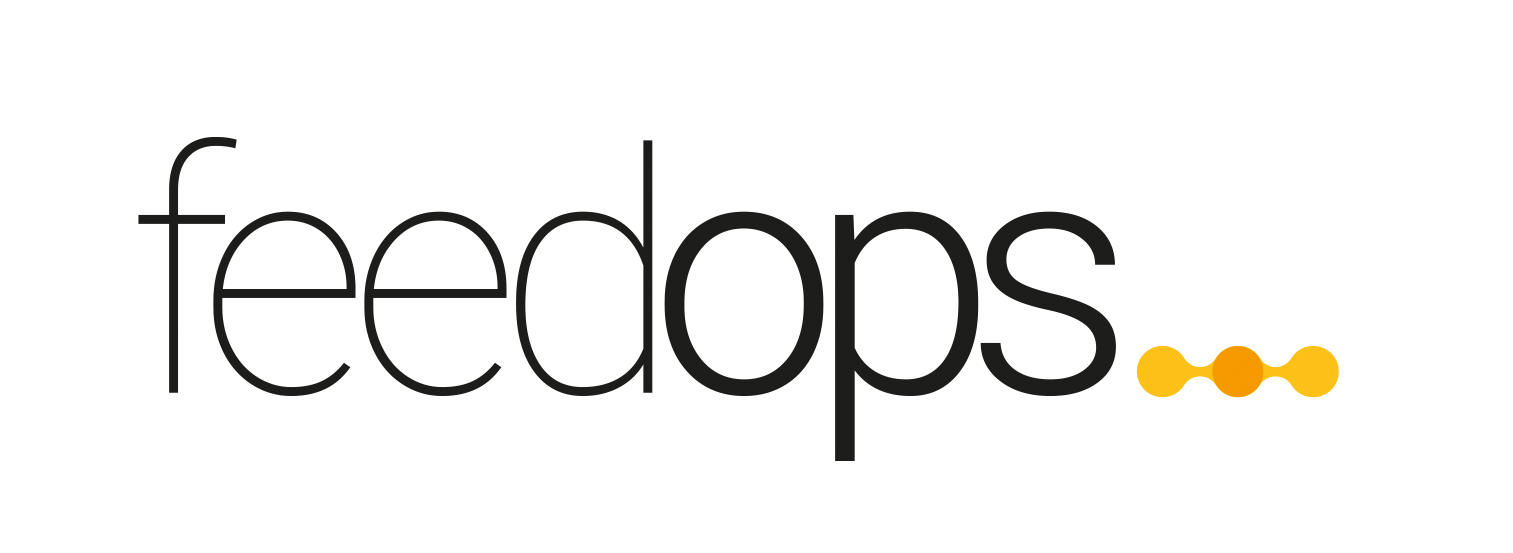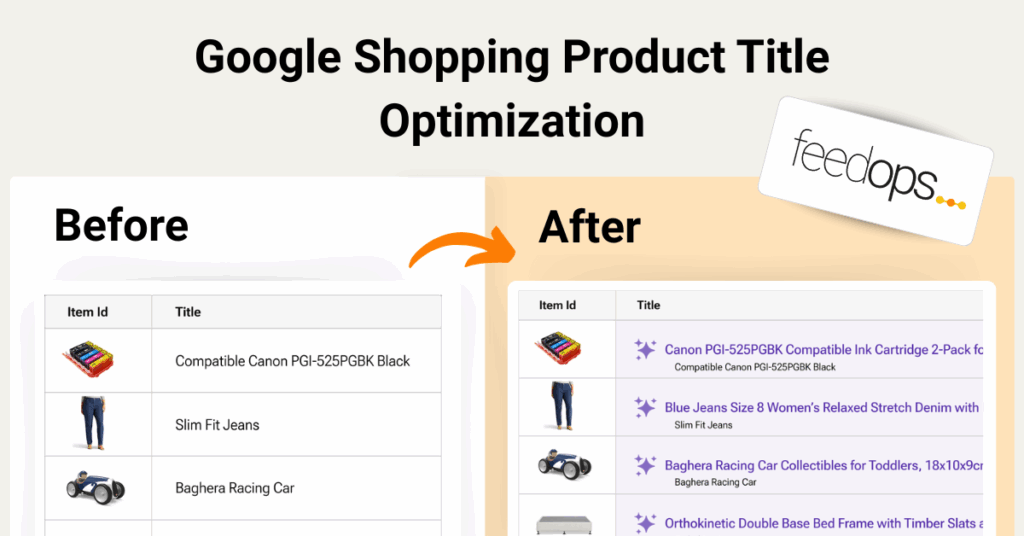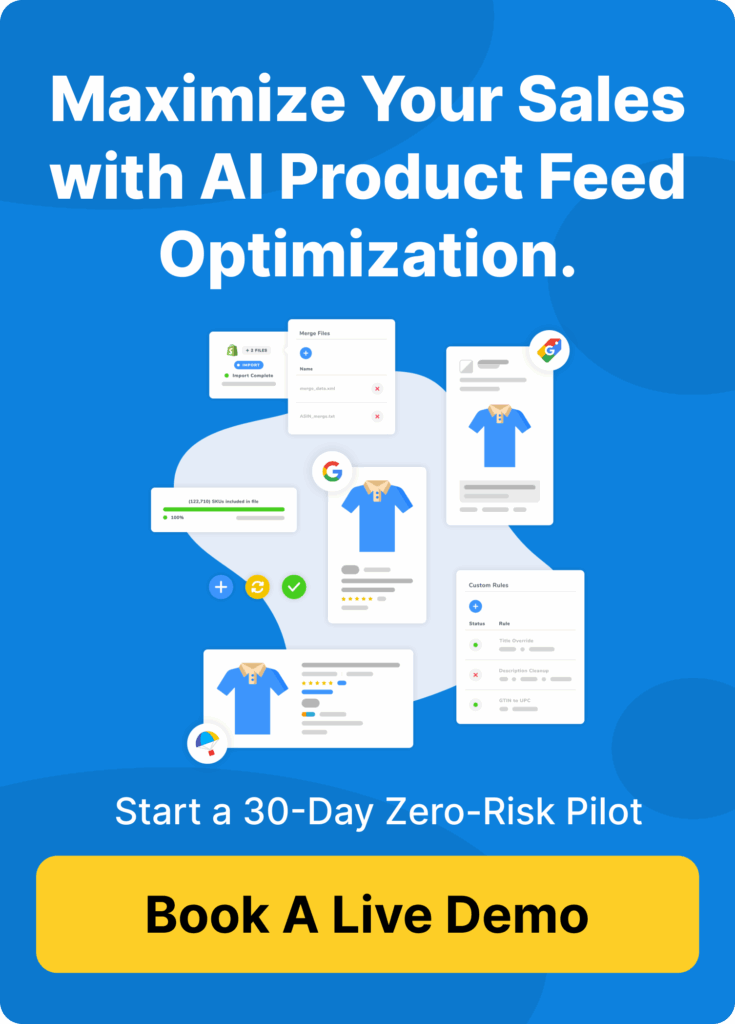Google Shopping Product Title Optimization is the single most powerful lever to improve visibility, clicks, and sales in Shopping campaigns. Your product titles aren’t just labels — they’re the headline of your ad, and they determine whether shoppers find, click, and buy your products. By refining titles so they go beyond Google’s minimum requirements, you gain a competitive edge in crowded auctions.
If you want to lower CPC, expand your reach, and improve ROAS, title optimization is where to start.
What Is Google Shopping Product Title Optimization?
At its core, Google Shopping product title optimization means writing titles that do more than get your products approved in Merchant Center. A “compliant” title simply gets your ad listed. An “optimized” title ensures your product is discoverable, compelling, and relevant to the queries that matter. For example:
Compliant Title (via website): Running Shoes Size 10
Optimized Title (modified by templates): Nike Men’s Running Shoes – Air Zoom Pegasus 40 Black Size 10 – e.g.
[Brand] [Category] – [Model] [Colour] [Size]AI-Optimized Title (via AI product feed tools like FeedOps): Nike Air Zoom Pegasus 40 Men’s Black Running Shoes – Lightweight Comfort in Size 10
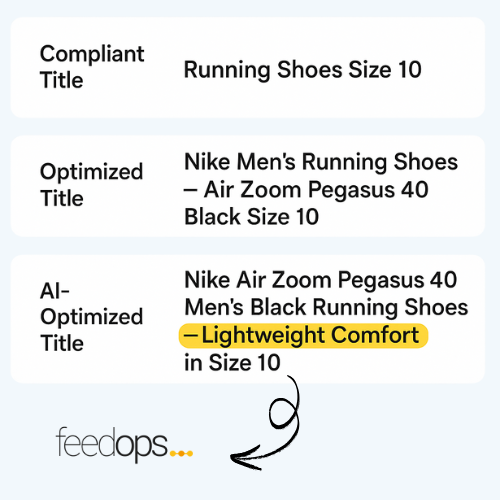
The difference? The optimized version is keyword-rich and structured, while the AI-optimized version uses natural language — aligning more closely with how people actually search. This approach naturally introduces long-tail phrases like lightweight running shoes, comfortable running shoes, or men’s black running shoes, helping your products match a wider range of high-intent queries.
How Google Shopping Product Title Optimization Impacts Performance
Google’s algorithm relies heavily on titles when matching search queries with products. Think of your title as the headline of your ad: if it doesn’t contain the terms shoppers are searching for, your products won’t surface — or they’ll appear for the wrong queries.
When a shopper searches “men’s waterproof hiking boots size 11,” Google is scanning your product title first to determine if your item is relevant. If your title just says Hiking Boots, your product is unlikely to show. But if your title reads Columbia Men’s Waterproof Hiking Boots – Size 11 Brown, Google immediately understands that your product is a strong match.
Optimized titles improve performance at every stage:
Impressions – Rich, keyword-driven titles match more queries, allowing your product to appear in a wider range of searches.
Click-Through Rate (CTR) – Shoppers are more likely to click when titles reflect exactly what they typed or had in mind.
Conversion Rates – Accurate, descriptive titles set expectations upfront, reducing wasted clicks and improving the chance of purchase.
In other words: titles aren’t just about visibility, they’re about efficiency. They help you attract the right traffic — people who are ready to buy.

Several FeedOps clients have achieved striking results:
A 33% boost in non‑branded search terms
A 139% jump in Organic Shopping revenue
Nearly double organic clicks on optimized products in just five weeks
Click to read the full client stories at FeedOps.com
How to Optimize Product Titles For Google Shopping: 7 Best Practices
When building or refining Google Shopping product title optimization, keep these best practices in mind.
1. Put Primary Keywords First
Google gives the most weight to the words at the beginning of your title. That means your title should start with the most meaningful element—whether that’s product type or brand. Then highlight the standout features. In the example below, we’ll use a brand name. But first, pause to run a keyword research tool. That gives you a clear view of how people search. For sellers with lesser-known or generic brands, leading with product type may make more sense.
Example:
Weak: Size 10 Running Shoes – Nike Black Air Zoom Pegasus 40
Strong: Nike Men’s Running Shoes – Air Zoom Pegasus 40 Black Size 10
In this example, leading with the brand and product type aligns immediately with high-intent queries like Nike running shoes rather than generic searches.
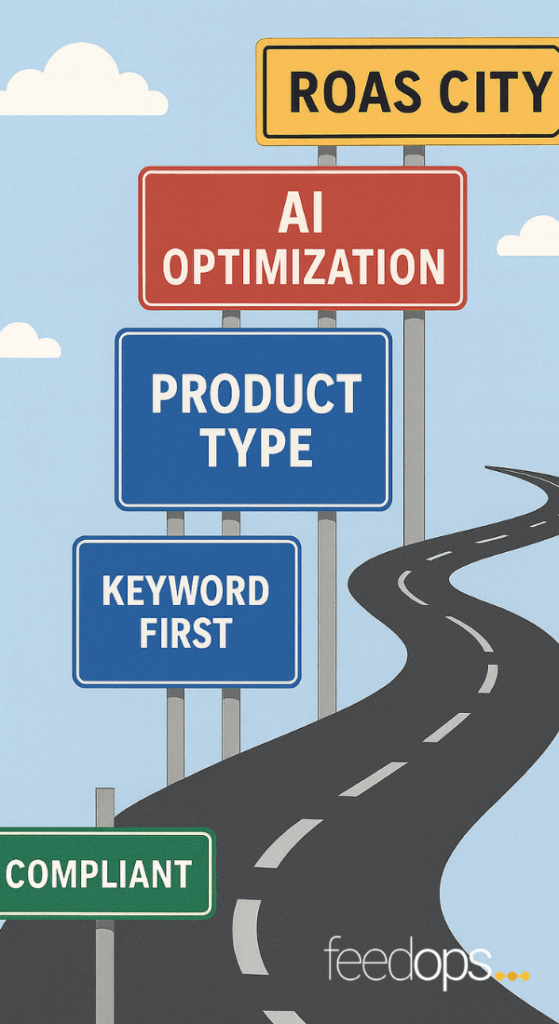
2. Follow a Clear Structure
Structured titles make it easier for Google to understand your product and easier for shoppers to scan quickly. The most widely recommended formula is:
Brand + Product Type + Key Attributes (size, color, style, gender, model)
Example (Electronics):
Samsung 55” 4K Smart TV – QLED HDR Dolby Atmos
This structure ensures every word is purposeful, and the most valuable details are present without clutter.
If You’re Using a Plugin That Pushes Data Directly From Your Store
Many merchants rely on plugins or apps that simply sync product titles from their site straight into Google Merchant Center. In these cases, you need to make sure the title on your website itself follows the right structure. The upside? This is also a best practice for SEO — search engines like Google Search value descriptive, keyword-rich titles just as much as Shopping campaigns do.
However, there’s often a compromise between SEO and user experience. For example, you may not want every product page on your site to display size or color in the page title if those details are already clearly shown elsewhere (dropdowns, swatches, on-page copy).
This is where feed management tools like FeedOps give you more flexibility. Instead of being forced to use a single “master” product title everywhere, FeedOps lets you map multiple fields together (brand, product type, attributes, custom labels) to dynamically generate optimized Shopping titles — while keeping your on-site titles clean and user-friendly.
That way, you get the best of both worlds:
SEO-friendly product titles on your website.
Optimized, attribute-rich titles in your Shopping feeds.
3. Stay Within Google’s Character Limit
Google allows up to 150 characters, but in most cases only the first ~70 characters display. That means the front half of your title is prime real estate.
Best Practice:
Make sure the most important keywords are placed before the cut-off.
Use the remaining space for secondary attributes that may help with long-tail queries.
Example:
Apple MacBook Air 13-inch Laptop – M2 Chip, 256GB SSD, Silver (2024 Model)
4. Avoid Keyword Stuffing
Cramming your title with keywords doesn’t make it stronger — it makes it look spammy and hurts CTR. Google may also flag overly repetitive titles.
Bad Example:
Shoes Running Nike Men’s Shoes Nike Running Size 10 Black Running Shoes
Good Example:
Nike Men’s Running Shoes – Air Zoom Pegasus 40 Black Size 10
Readable, relevant, and still rich in search terms.
5. Include Unique Selling Points (Sparingly)
Adding differentiators like “Waterproof,” “Eco-Friendly,” or “Limited Edition” can increase CTR, but they should be used only when they are true selling points and not filler.
Example:
Hydro Flask Stainless Steel Water Bottle – 32oz, Wide Mouth, BPA-Free, Insulated
6. Keep It Specific
Generic titles may technically pass Google’s requirements, but they rarely rank well or attract clicks. Shoppers want to see the exact item they’re searching for.
Weak Example: Laptop
Strong Example: Apple MacBook Air 13-inch M2 Chip 256GB SSD Silver
7. Optimize for Long-Tail Keywords
This is where AI-optimized, natural language titles shine. Instead of targeting only short, competitive terms like running shoes, well-crafted titles introduce long-tail variations that capture very specific buyer intent.
Example:
Optimized Title: Nike Men’s Running Shoes – Air Zoom Pegasus 40 Black Size 10
AI-Optimized Title: Nike Air Zoom Pegasus 40 Men’s Black Running Shoes – Lightweight Comfort in Size 10
The AI-generated version adds natural descriptors like lightweight and comfort, which pull in long-tail searches such as lightweight men’s running shoes or comfortable black running shoes size 10. These queries often convert better because they come from shoppers who know exactly what they want.
Frameworks for Structuring Titles
Here’s how you can apply frameworks across categories, with compliant → optimized → AI-optimized examples, plus the long-tail benefit callouts:
Apparel
Compliant Title (via website): Running Jacket
Optimized Title (via templates): Adidas Women’s Running Jacket – ClimaCool Lightweight Blue Medium
AI-Optimized Title (natural language): Adidas ClimaCool Women’s Blue Running Jacket, Lightweight & Breathable – Size Medium
👉 The AI version introduces long-tail searches like lightweight women’s running jacket, breathable running jacket for running, and blue running jacket size medium. These are highly intent-driven and often signal shoppers closer to purchase.
Electronics
Compliant Title (via website): Smart TV 55 inch
Optimized Title (via templates): Samsung 55” 4K Smart TV – QLED HDR Dolby Atmos
AI-Optimized Title (natural language): Samsung 55-Inch QLED 4K Smart TV with HDR & Dolby Atmos Surround Sound
👉 The natural language style adds long-tail terms like Samsung 55-inch QLED TV with HDR, smart TV with Dolby Atmos surround, and best 55-inch 4K TV for movies. These variations expand your reach into detailed buyer searches with higher conversion potential.
Home Goods
Compliant Title (via website): Dining Table 6 Seater
Optimized Title (via templates): IKEA Dining Table – Solid Oak Scandinavian Style 6-Seater
AI-Optimized Title (natural language): IKEA Solid Oak Scandinavian Dining Table, Seats 6 Comfortably – Modern Minimalist Design
👉 The AI-driven version brings in long-tail queries like Scandinavian oak dining table for 6 people, modern minimalist 6-seater dining table, and comfortable dining table for family meals. These types of searches often come from shoppers in the final decision stage.
When to use each:
Compliant titles → Just enough to get products approved in Merchant Center.
Optimized titles → Structured, keyword-rich, and campaign-ready.
AI-Optimized titles → Natural, scalable, and packed with long-tail variations that align with evolving search intent.
Common Mistakes in Title Optimization
Even seasoned retailers make avoidable mistakes when it comes to product titles. Here are the most common pitfalls:
Overstuffing with Keywords
Example: Shoes Running Nike Running Shoes Size 10 Running Black Shoes
Why it’s bad: It looks spammy, confuses shoppers, and risks disapproval from Google.
Leaving Out Critical Attributes
Example: Women’s T-Shirt
Missing: Size, color, material. Without these, your product will lose out to competitors with more detailed titles.
Duplicating Titles Across Products
Example: Every SKU titled Men’s Hoodie.
Why it’s bad: Google struggles to differentiate products, and shoppers don’t see what’s unique about each item.
Ignoring Seasonal or Trend Keywords
Example: Keeping the title Running Shoes year-round, instead of adding Back to School Running Shoes or Christmas Gift Running Shoes.
Seasonal tweaks can improve visibility when demand spikes.
Using Internal Codes or Jargon
Example: XYZ123 Product – Model 5678.
Shoppers don’t search by SKU or internal codes — they want descriptive, plain-language titles.
How AI and Automation Enhance Title Optimization
Optimizing product titles at scale is nearly impossible manually — especially when managing thousands of SKUs across multiple channels. This is where AI and automation make the difference:
Dynamic Attribute Mapping
FeedOps can pull data from multiple fields (brand, color, material, size) and merge them into a clean, structured title without you needing to rewrite each one manually.Natural Language Enrichment
AI models analyze how people actually search (in conversational terms) and weave those descriptors into titles, automatically generating long-tail coverage like lightweight, eco-friendly, or best for beginners.Always-On Optimization
Unlike manual edits, AI continuously adapts titles based on seasonal terms, trending keywords, and changes in your inventory.Error Prevention & Fixes
Automation ensures titles remain compliant with Google policies (no promotional text, no ALL CAPS abuse, etc.) while maximizing keyword value.
The result? Titles that are not only campaign-ready but also continuously improving, giving you compounding performance gains over time.
Advanced Strategies for Competitive Edge
Once you’ve mastered the basics, these advanced strategies can push your results even further:
Prioritize High-Value SKUs
Focus title optimization efforts on your top sellers or highest-margin items first. These products drive the biggest impact.
Use Custom Labels for A/B Testing
Create different versions of titles (e.g., with or without descriptive adjectives) and use Merchant Center custom labels to test performance in campaigns.
Align Titles With Campaign Goals
For Performance Max, optimized titles help Google understand which products should be prioritized for clicks vs. conversions.
Example: A campaign focused on margin efficiency may benefit from including attributes like premium or luxury.
Leverage Omnichannel Benefits
Optimized titles don’t just improve Shopping ads — they also improve visibility in marketplaces like Amazon, eBay, and social commerce platforms.
Strong, consistent titles improve SEO rankings, boost marketplace discoverability, and enhance shopper trust.
Update Titles for Seasonality & Trends
Add “Summer Collection”, “Back to School”, or “Christmas Gift” when relevant. AI tools can suggest and scale these seasonal modifiers across your catalog.
By layering these strategies on top of best practices, you move from simply having compliant feeds to running competitive, revenue-driving campaigns.
Free Guides (no email required)
- For more Optimization Techniques see Google Shopping Feed Optimization Guide
- To learn more about Feed Management, See – Google Shopping Feed Management Guide
Frequently Asked Questions: Google Shopping Product Title Optimization
Do I really need to include brand names in every product title?
Not always. If your brand is well-known, leading with it usually improves visibility and trust. If you sell a lesser-known brand or private label, it may be better to lead with the product type or category that shoppers actually search for (e.g., “Wireless Earbuds” instead of “XYZ Brand Earbuds”).
What happens if I don’t optimize my titles and just push them as-is from my site?
Your products may still be listed, but you’ll likely waste impressions on irrelevant searches and struggle with low CTR. Titles pulled directly from your store often lack critical attributes like size, color, or style. That means you’ll miss out on high-intent queries that competitors are winning.
How do long-tail keywords in product titles actually help?
Long-tail keywords are more specific and less competitive than broad terms. Someone searching “lightweight men’s black running shoes size 10” is closer to making a purchase than someone just typing “shoes.” By introducing long-tail terms in natural language titles, you capture these higher-converting searches without extra ad spend.
Is there a risk of making product titles too long?
Yes. Google allows up to 150 characters, but only ~70 show in most placements. Overly long titles may get truncated, hiding important info. The best approach is to front-load key details and keep titles concise while still descriptive.x
Should product titles match my SEO titles on my website?
Not exactly. Website titles often balance SEO, branding, and user experience. Shopping feed titles should be more structured and attribute-rich. Tools like FeedOps let you keep clean, SEO-friendly titles on your website while generating optimized titles for your feeds.
Can title optimization alone fix poor campaign performance?
No single change fixes everything, but titles are often the biggest lever. They improve impressions, clicks, and relevance. For best results, pair strong titles with optimized product data (descriptions, images, attributes) and well-structured campaigns.
How often should I update or refresh my product titles?
At minimum, review your top products every season or when trends change. Titles may need refreshing to capture seasonal intent (e.g., “Christmas Gift” or “Back to School”). With AI tools, you can keep titles adapting automatically to trends and inventory changes.
Does Google penalize keyword stuffing in titles?
Yes, indirectly. While you may still get approved, keyword-stuffed titles usually see lower CTR and relevance scores. Google’s AI looks for clarity and intent match. Titles that read naturally nearly always outperform “spammy” ones.
Do AI-optimized titles ever sound unnatural or off-brand?
They can if not guided properly. That’s why tools like FeedOps combine AI with rules and human oversight. This ensures titles remain natural, brand-safe, and consistent, while still introducing valuable long-tail coverage.
Will optimized product titles also improve my performance in marketplaces like Amazon or eBay?
Yes. Structured, attribute-rich titles generally improve search visibility and ranking across marketplaces as well. While each channel has its nuances, the core principles of clear, descriptive, keyword-aligned titles apply everywhere.
